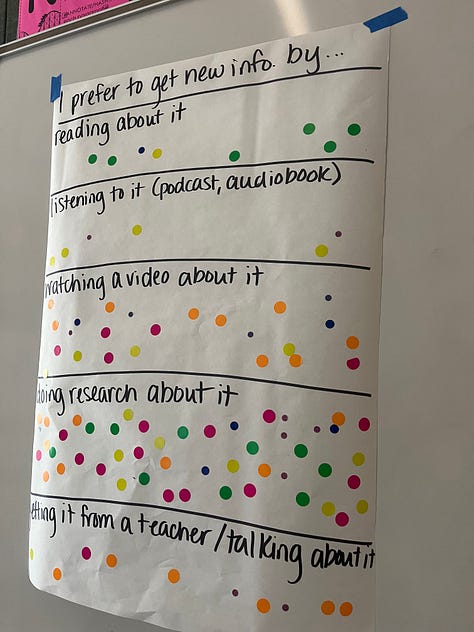
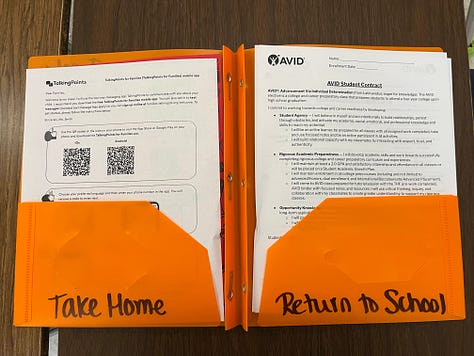
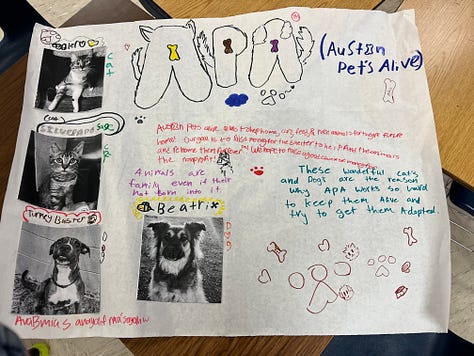
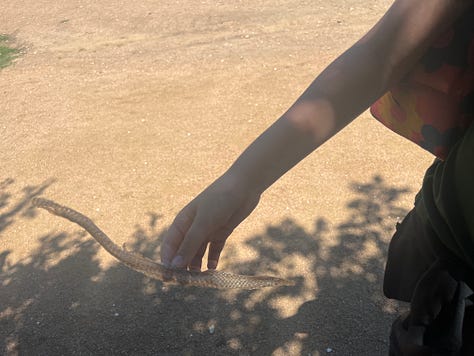
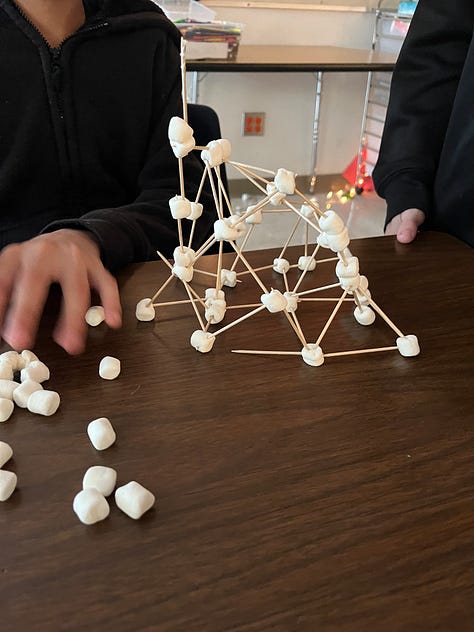
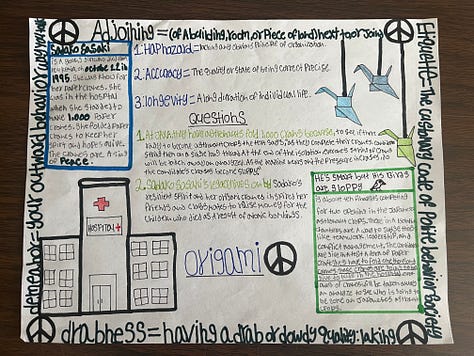

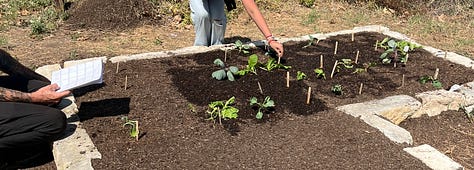
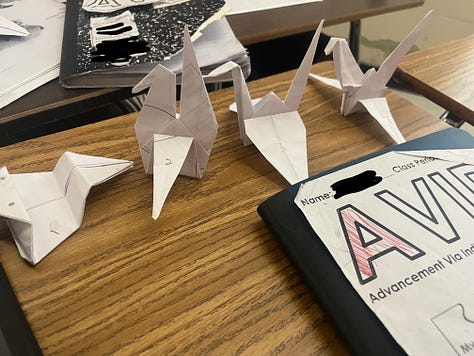
I feel like you could teach in a classroom for a hundred years and still have things you wanted to change, adjust, fix, and learn. I’m always learning something totally new, or re-learning something that I thought I learned but didn’t really, or really learning something that I thought I’d understood by hadn’t. A non-exhaustive list of takeaways from this year are below. Interestingly, none of them are about balancing between my job and my out-of-work time, because I’m honestly not sure I learned anything conclusively in that area this year, save for: the work will never be done. The sooner you can accept that, the more quickly you can learn about space.
Top Learnings:
Kids need to make stuff.
Obviously, as a crafty young person myself, I know this. AND I think I’ve shied away from it because making things tends to come with a lot of anxiety, shame, and fear of “doing it wrong,” especially when working in groups. So I haven’t done it with my students as much as I should have. While it’s not a failsafe (some students do truly hate it, and some of them rush through it just to be done, and some of them struggle with fear of the blank page), engagement is higher when we are making things, even when it’s not going great, than otherwise. This year, we made friendship bracelets and marshmallow/toothpick structures and and posters and vision boards and so much origami.
Relationships are not everything, and they take time.
It’s a truism that relationships are everything in teaching. I’ll be the first person to argue that relationships are CRITICAL to effective teaching, but I do not believe that they are everything. You can be as warm and welcoming as you want, but if you cannot structure a class and make a plan and help students feel successful academically as well as personally, the relationships won’t reach the potential that they could. As much as I sometimes want to be my students’ therapist or their friend, that’s not my role, and maintaining clear lines for myself for what’s mine to do and what’s really not has been immensely helpful, especially with some of the students with whom I had fraught relationships last year.
I also find that sometimes/often, young people need me to back off and give them space to decide what they think about me. As someone who’s deeply relational in my work with adults, this is hard, especially when I know that nine months feels like a lifetime to them but is really more of a flash in the pan. I can be warm, but I don’t have to be up in their business (unless they choose to put me there) to do my job effectively.
Just because they aren’t telling me their life story doesn’t mean 1.) that I’m a bad teacher or 2.) that they aren’t learning.
I’m a slow burn anyway (in a normal school year, it’s around March before I start to see the payoff of relational work academically), but in looping with about 85% of my students from sixth to seventh grade this year, I’ve gotten to really sink into the benefits of starting the year with a warm but professional foundation from last year. Some of the students who I thought hated me (and did hate my class) last year are the ones who I’ve seen the most growth in this year. I am enjoying building deeper connections with these students, but they are also teaching me that sometimes you just have to do the work - and let the relationship come in its own good time (or not).
None of this should be shocking, necessarily. While I love a deep, instantaneous sparks-flying conversation (I’m a Gemini, after all), I also know that these aren’t always the enduring relationships that I’m actually trying to cultivate. Especially in a professional capacity, I tend to prefer knowing someone knows their stuff first: a sense of deep professional respect can grow into personal intrigue and friendship from there. Why it surprises me that my students want to see that I know what I’m doing as a teacher (and that I’m strong enough to resist their constant pleas for free time or easy work because I respect their intellectual and personal potential), I’m not sure.
Oddly, this has shown up in my yoga teaching as well. I’ve wrestled with the idea that I’m not getting better or building a wider base as a yoga teacher as fast as I’d like to be. My teacher has reassured me (again and again and again) that this is because I’m not DOING it enough (one class a week, which feels like a worthwhile Herculean feat for my schedule, is VERY different from six classes a week). Most of the people attending my classes and workshops are friends (and I’m grateful for you all!). But some of the people who’ve come consistently or expressed significant learning are people I know peripherally from my studio or friends-of-friends.
My teacher mentioned above, who’s shaped my practice the most, was a similar journey for me; I liked the way her classes made me feel, and I liked how they made logical sense, and so I kept going back. But we were three years in before I told her anything about myself, and another two years before I started asking big questions and relating in a way that wasn’t purely within the structure of a weekly-ish practice. Now, that relationship (and other close relationships at school and from my previous jobs) is something I value so deeply it’s hard to capture in words, but it wasn’t always like that. I could learn and grow and find my way because she was a good yoga teacher, like I hope that my students will find benefits from the classes I teach whether they ever engage with me on a personal level.
Mirror neurons are no joke.
(Otherwise known as: kids know when you are feeling the urgency of whatever you feel urgency from and will react to it. Additionally: learning has to invoke elements of fun or you will lose them.) The students I’ve had now for a year and a half are very attuned to my emotional state, both what I’m projecting outwardly and what I think I’ve managed to gloss over. The mirror neuron phenomenon tends to be particularly strong with people of authority, both as a protective and a responsive force.
What I thought this meant until the past couple of years is that I had to perfectly mask everything I was feeling, and that that was even possible. What I feel like has sunken in deeper this year is that I can make our days better by taking a breath and staying calm when things are hard. Additionally, I’ve internalized (at least somewhat more) that articulating what I’m thinking or feeling and why I’m thinking or feeling it can help mitigate the mirroring of anything negative that I’m projecting, especially when students (because they will) call out my emotions, sometimes before I’ve even realized what I’m feeling. “I’m feeling xxx today because…” or even “Things are a little bit chaotic and I’m not sure what I’m feeling, exactly” both go a long way toward modeling what I hope students will learn to do and making sure that I’m not making our time together harder than it needs to be. I’ve also really tried to include games and community builders as often as I can face it (not my favorite activities, so it’s hard to make myself plan them); sometimes we really just need a 15-minute break to have a colored sticker on our forehead and try to line ourselves up in rainbow order or make groups of warm and cool colors.

We all need to be outside more.
After re-reading Robin Wall Kimmerer’s Braiding Sweetgrass last February, it became my mission to find ways for my students to engage more purposefully and frequently with nature. This is tough for a number of systemic reasons, but with some careful partnering with our rockstart librarian and gardener, my kids have been outside more than I could have imagined. We took a field trip to a farm and to two parks. We’ve grown and tasted our own vegetables and tracked the weather and made connections to how we feel different in different weather. We’ve found different examples of plant parts, drawn them, described them, researched them, presented them. And, whining about the weather aside, it’s impossible not to notice how engagement spikes when students connect to something they haven’t known (or knew they knew) about the natural world. 10/10. Will continue to find ways to keep doing.
Two quotes from my reading and other explorations have stood out this year in relationship to teaching.
As a teacher and mentor, I know that I can’t be responsible for leading anyone deeper than I’ve gone. To stay within integrity and alignment, I have to be honest when I’ve walked with a student or mentee as far as I can go with them…some people/teachers know they can’t go with us. Those teachers hold vigil. They stay at the base camp and tend to the fire that we’ll need when we make it home. They pray for us on our journeys, and they release us to our destinies…at the darkest turn, we may think we are alone. Remember. Remember someone’s tending the fire and trusting you’ll make it through. -Octavia Raheem, Pause Rest Be (emphasis mine)
“We are all new at teaching when we start. We are all young at teaching, no matter how old we are in years. That’s why the practice is all there is.” - Gillian St. Clair
I’d love to hear what work epiphanies you’ve had this year, or what you’re continuing to wrestle with.




I love getting to learn these details about your teaching. I am just blown away by the incredible educator you are. Your students are so lucky to have you. The amount of work and care that you put into your role as a teacher is so beautiful. I know it’s hard, but this post really let me in to seeing the beauty of it too. Thank you for sharing!